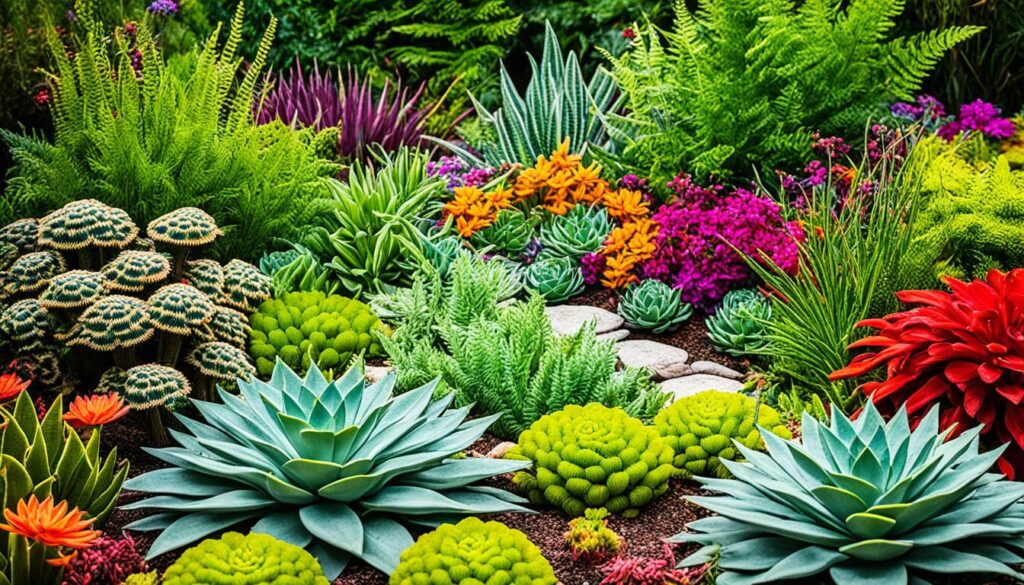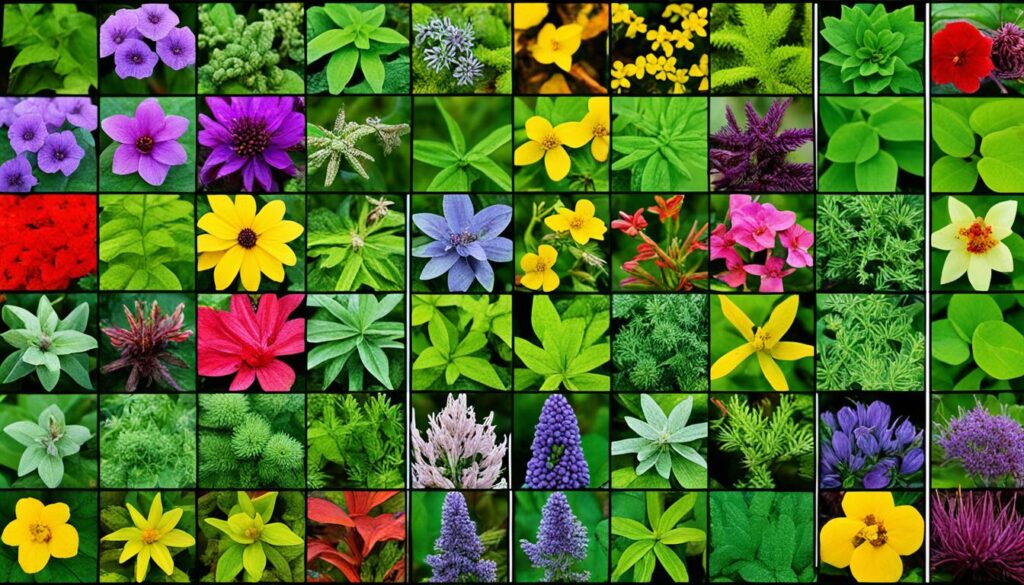Do you know about the dangerous plants right outside your door? Many of the plants we see every day can actually be very harmful. It’s important to be aware of the poisonous plants you might have. Learning about these toxic flora can help you make your home safer, keeping your family and pets away from risk.
There’s a standard, Caring for Our Children, that says child care places shouldn’t have dangerous plants. If you’re not sure if a plant is safe, you can call the Poison Control Center at 1-800-222-1222. They’ll help you check if it’s venomous foliage. Knowing about these risks is the first step to keep your family away from harmful botany.
Understanding the Dangers of Poisonous Plants
As someone who works with plants every day, I get lots of questions about keeping Poisonous Plants in the home. Many plants we find at home and in our gardens are dangerous. They carry Venomous Foliage and can harm you and your pets. Knowing about these risky plants, like Lantana (Lantana camara) and Mountain Laurel (Kalmia latifolia), is very important.
Potential Health Risks
Touching or eating Poisonous Plants can be very harmful. They might make you vomit, feel dizzy, or have trouble breathing. Even plants that seem safe, like Giant Hogweed, can cause bad skin reactions. So, being careful is key.
Common Sources of Poisonous Plants
Some dangerous plants are pretty common, from beautiful flowers to house plants. Being aware of these Toxic Flora is crucial. It helps keep your family and pets out of danger.
Importance of Plant Identification
It’s very important to know which plants are dangerous. This way, you can be sure your home and garden are safe. Learning about Harmful Botany and Noxious Greenery is a smart move.
Identifying Common Poisonous Plants
Many common veggies we grow are actually poisonous. For example, eggplant, peppers, potatoes, and tomatoes belong to the Nightshade family (Solanaceae). This means they are toxic. So, it’s best to steer clear of their leaves and stalks if you’re cooking.
Lilies and Daffodils
The lily of the valley is a beautifully scented yet toxic plant. It contains a dangerous compound called cardiac glycosides. Ingesting it can lead to serious issues like vomiting, dizziness, and in some cases, death.
Foxglove (Digitalis purpurea)
Even though its seeds can be deadly, castor bean plants are intriguing. Castor oil is made from its seeds and has health benefits. Yet, ricin, a toxin in the seed, can dehydrate anyone, especially a child.
Poisonous Plants Around the Home
Keeping your home safe is vital. Be aware of poisonous plants indoors and outdoors. Plants like Lantana (Lantana camara), Bitter Nightshade, and Mountain Laurel (Kalmia latifolia) can be dangerous. Make sure you know these toxic flora and protect your family and pets.
Indoor and Outdoor Plants
Some hazardous vegetation is easy to spot. But others, like Chinese Lanterns (Physalis alkekengi), may seem harmless with their bright colors. The Stinging Nettle and Giant Hogweed can cause nasty rashes. Knowing about these dangerous plants is key to safety.
Holiday Plants: The Poinsettia Myth
The poinsettia and its toxicity is a common misunderstanding. It’s only mildly toxic, with low risk of serious harm. Yes, its sap can irritate the skin and eyes. But it’s much safer than other plants that can be fatal if eaten.
Poisonous Plants in the Garden
Many of us love working in the garden. We plant all kinds of beautiful flowers and plants. But, not all plants are safe. Some of the pretty ones can be poisonous. Let’s look at which ones to watch out for and a cool trick some have to keep pests away.
Ornamental Flowering Plants
In the south, we fill our gardens with bright, colorful plants. One such plant is the Hydrangea macrophylla. Its flowers and leaves have cyanide in them. Yet, to cause harm, you’d need to eat a lot. But beware, hydrangeas are not safe for pets and considering this, deer are attracted to them.
Larkspur: A Deer-Deterring Toxic Beauty
Larkspur is my top pick for beautiful yet deadly plants. I plant it all over in spring to keep deer and other pests at bay. Every part of larkspur is poisonous. But, its new growth and seeds are the most dangerous. They can even kill an adult human with just two milligrams. But, since animals seem to know it’s harmful, they avoid your garden.
Precautions for Safeguarding Your Home
The saying «Leaves of three, let it be!» helps spot poison ivy and poison oak. But, it’s not true for poison sumac, known for its 7–13 leaf clusters. Poison ivy and poison oak might have more than three leaves too. Their look changes based on the species, environment, and season. Knowing how to spot poisonous plants can keep you safe.
Supervision of Children and Pets
Always watch kids and pets near poisonous plants. Use gloves and be careful when touching or removing toxic flora.
Proper Plant Handling and Disposal
Make sure to supervise kids and pets near poisonous plants. Wear gloves and handle toxic flora with care.
Non-Poisonous Plant Alternatives
The National Capital Poison Center has a list of non-poisonous plants for every home. It includes African violet, begonia, and Christmas cactus. You can also safely enjoy coleus, dandelion, and dracaena. Forsythia, impatiens, jade, and marigold are on the list too.
Adding petunia, rose, spider plant, Swedish ivy, and wild strawberry is a good idea. These Poisonous Plants and Toxic Flora are risky. So, plant the safe ones without the threat of Hazardous Vegetation or Dangerous Plants.
Instead of risky Venomous Foliage or Harmful Botany, choose wisely. Opt for Noxious Greenery and Risky Horticulture options. For instance, Lantana (Lantana camara), Bitter Nightshade, and Mountain Laurel (Kalmia latifolia) are not safe. But, Chinese Lanterns (Physalis alkekengi), Stinging Nettle, and Giant Hogweed can be harmful.
Although Yellow Dock and Rosary Pea are not safe, many other plants are. These non-toxic choices are just as pretty. They bring charm without the danger.

By picking these safe, Poisonous Plants-free options, your place will look amazing. It will be a Toxic Flora-free zone. Your family and pets can roam worry-free.
First Aid for Poisonous Plant Exposure
If a child or pet eats a mushroom or touches plants like Lantana (Lantana camara), Bitter Nightshade, or Stinging Nettle, act fast. Call the Poison Control Center at 1-800-222-1222 right away. They will tell you what to do next if your loved one has touched or eaten something harmful.
Recognizing Symptoms
It’s key to spot poisonous plant exposure symptoms like throwing up, feeling dizzy, getting itchy, or having trouble breathing. Knowing these signs helps keep people safe from the effects of poisonous plants.
Seeking Medical Assistance
Getting medical help as soon as you think someone might be poisoned is very important. Doctors can treat them fast to lessen the danger. This quick action is crucial for people who have been in contact with poisonous plants.
Poisonous Plants
Many plants are poisonous and grow in or near our homes. They include azaleas, rhododendrons, castor beans, and many more. We must learn to spot these toxic plants to keep our loved ones safe.
Common Toxic Plants in the Home
Indoor plants like azaleas and rhododendrons can be very dangerous. There are many others, such as daffodils and elephant ears. Knowing and avoiding these toxic flora is key to home safety.
Outdoor Poisonous Flora
Some toxic plants are found outside, like lantana and giant hogweed. They can harm us and our pets. It’s critical to recognize and stay away from them outside.
Identifying Poisonous Plants by Appearance
The saying «Leaves of three, let it be!» helps spot poison ivy and poison oak. Yet, it doesn’t work for poison sumac, which shows 7–13 leaves in clusters. Poison ivy and oak can have more than three leaves. They look different according to the type, where they grow, and the time of year.
Leaves of Three, Let It Be
Learning what poisonous plants look like in all seasons can prevent contact. This is crucial to avoid mistakenly touching their non-poisonous lookalikes. Even Lantana (Lantana camara), Bitter Nightshade, and Mountain Laurel (Kalmia latifolia) can be misidentified by those not aware of their specific details.
Distinguishing Poisonous Lookalikes
Lookalikes of Chinese Lanterns (Physalis alkekengi) can appear like tomatillos, making them seem safe to eat. Mistaking Stinging Nettle and Giant Hogweed for friendly plants is easy, but they’re toxic. Yellow Dock and Rosary Pea have similar-looking plants that are not harmful. Knowing how to spot these toxic plants keeps you, your home, and garden safe.

Landscaping with Safety in Mind
Landscaping your home means making it beautiful and safe. Make sure the plants you choose are not toxic. This is key for child and pet-friendly spaces. Don’t plant dangerous species like azaleas, rhododendrons, and foxglove. They can be very harmful. Instead, choose safe plants that also look good and keep pests away.
Researching Plant Toxicity
It’s important to know which plants in your area could be dangerous. Learn about Bitter Nightshade, Mountain Laurel (Kalmia latifolia), and other risky plants. Talk to nurseries, garden experts, or look online. They can guide you on safe choices for your garden.
Creating Child and Pet-Friendly Spaces
Always watch children and pets around plants. Keep harmful plants away from them or take them out. This keeps your family and pets safe from plant dangers.
Education and Resources
If you’re not sure about certain plants like Lantana (Lantana camara), Bitter Nightshade, Mountain Laurel (Kalmia latifolia), and others in your yard, call the Poison Control Center at 1-800-222-1222. They can tell you which plants are dangerous and how risky they might be.
Poison Control Center
The Poison Control Center is key if you worry about risky plants. They’re your go-to for knowing if the plants around could harm your family or pets.
Local Nurseries and Experts
It’s also smart to talk with the folks at local nurseries and gardening experts. They know what plants are safe and can guide you to choose the best ones. This helps you make your garden a safe place for kids and pets.
Learning and using these helpful resources can keep your family safe from toxic plants.
Myth-Busting: Poinsettias and Other Misconceptions
Poinsettias are often thought to be very poisonous, but that’s not really true. They can be mildly toxic. Their sap, which is milky, has some chemicals similar to those in soaps. But, these are rarely dangerous unless someone eats a big amount. In that case, they might get a bit sick, like throwing up or drooling.
It’s smart to wear gloves when you touch poinsettias because their sap can irritate your skin. If it gets in your eyes, it’s also quite painful. Despite this, poinsettias are not as risky as many other poisonous plants. These other plants can be deadly if ingested.
Some people believe that all harmful plants look dangerous. But that’s not true. Many toxic flora can look just like regular plants. Things like Lantana (Lantana camara), Bitter Nightshade, and Mountain Laurel (Kalmia latifolia) look friendly but are actually unsafe. It’s vital to know your plants to keep your space safe.



